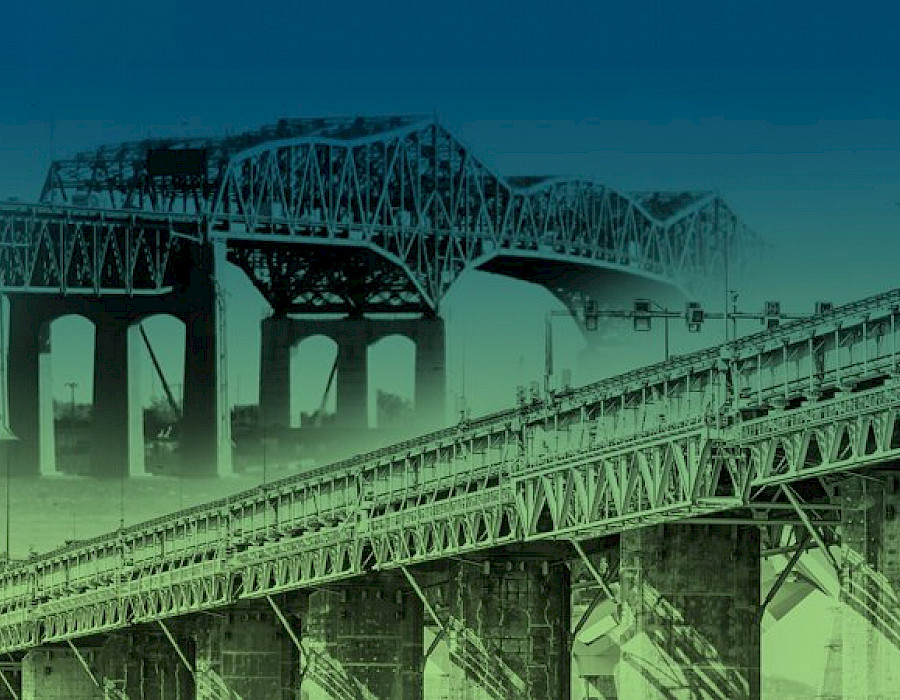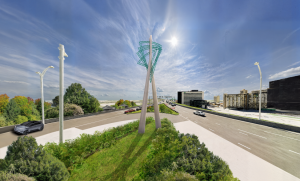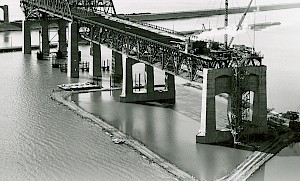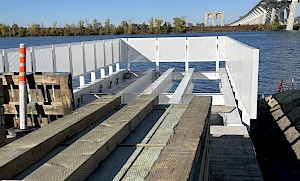- © 2025 The Jacques Cartier and Champlain Bridges Incorporated
- Terms of Use
- Site Map

Today, The Jacques Cartier and Champlain Bridges Incorporated (JCCBI) held a press conference to present the overall timetable for the deconstruction of the original Champlain Bridge and the methods that Nouvel Horizon Saint-Laurent G.P. (NHSL) has chosen for the project. JCCBI also provided a progress update for the project’s different components.
NHSL will deconstruct the bridge using three different methods. The deconstruction of the shoreline sections will be carried out from jetties set up along the river using standard equipment (excavators and cranes).
Work from the river, which will be required for over 65% of the project, will be done with a system of platforms attached to high-capacity lifting towers installed on a catamaran barge. Scheduled to take place from 2021 to 2023, this work will be performed in a controlled environment away from residences, respecting the river environment and the local community.
Work on the steel structure over the Seaway will begin in the fall and winter of 2021-2022. First, the 2,200-ton suspended span will be removed and lowered onto a barge using strand jacks. This will be followed by the dismantling of the cantilever sections and anchor spans using a crane set up on the jetties and the Seaway dike. The last phase will include the deconstruction of the bridge piers using high capacity excavators in 2023, and the demobilization of the jetties by the end of January 2024.
“The Champlain Bridge deconstruction project will create jobs, allow for more access to the shoreline and maximize the reuse of materials from a bridge that was an iconic part of the Montreal landscape for almost sixty years,ʺ said the Honourable Catherine McKenna, Minister of Infrastructure and Communities. “I’m happy that The Jacques Cartier and Champlain Bridges Incorporated and Nouvel Horizon Saint-Laurent are working together to ensure this project is carried out in a sustainable way that minimizes the impact on local communities and protects the environment for everyone’s benefit.”
“This ambitious deconstruction project poses enormous technical and environmental challenges. NHSL has begun working on Nuns’ Island, which is a successful first step. The methods chosen for work on the river are innovative and will minimize the impact on local residents,” said Sandra Martel, Chief Executive Officer, JCCBI. “We ensure constant follow-up with NHSL to make sure that exemplary OHS measures are in place at the work site,” she added.
NHSL Project Director Fabrice Guédon is also pleased: “We are very proud to contribute to this major deconstruction project that is on a scale never before seen in Quebec while respecting the environment and communities. Our know-how, combined with JCCBI’s high standards, will help us apply sustainable approaches that we hope will inspire new deconstruction practices for future projects.”
The deconstruction of the abutment and two spans on Nuns’ Island went well and was carried out to ensure compliance with environmental criteria and with minimum impact to the community. The closure of René-Lévesque Boulevard was unavoidable due to the scope of the work, but every effort was made to limit the closure duration and maintain a safe active transportation corridor.
In addition to the deconstruction, 10 research and development projects will be held on various components and aspects of the Champlain Bridge, such as its concrete elements, steel structures, and reinforcement techniques. The researchers have already begun their work, and some components were removed from the structure on Nuns’ Island. For more details, consult the Research and Development Program.
A first project to compensate for fish habitat started in Saint-Ignace-de-Loyola in the Saint-Pierre Lake archipelago. This project consists in developing a piece of farmland into a grassy floodplain that will promote fish spawning and protect the area’s biodiversity. It should also be noted that the impacts of the deconstruction will be limited to the duration of the work, whereas the impacts of the compensation projects are permanent. The overall long-term effect will be positive.
Virtual public meetings will be held on October 20 for Nun’s Island residents, and October 29 for Brossard residents so that the project details can be presented. Information about these meetings can be found on the Citizen Forum page. The public is also invited to get updates by subscribing to the project newsletter.
For more details about the Champlain Bridge deconstruction, click here.


